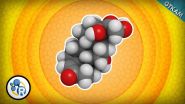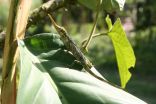(Press-News.org) Using archival data from the Japan-led Suzaku X-ray satellite, astronomers have determined the pre-explosion mass of a white dwarf star that blew up thousands of years ago. The measurement strongly suggests the explosion involved only a single white dwarf, ruling out a well-established alternative scenario involving a pair of merging white dwarfs.
"Mounting evidence indicates both of these mechanisms produce what we call type Ia supernovae," said lead researcher Hiroya Yamaguchi, an astrophysicist at NASA's Goddard Space Flight Center in Greenbelt, Maryland. "To understand how these stars explode, we need to study the debris in detail with sensitive instruments like those on Suzaku."
The researchers analyzed archival observations of a supernova remnant named 3C 397, which is located about 33,000 light-years away in the constellation Aquila. Astronomers estimate this cloud of stellar debris has been expanding for between 1,000 and 2,000 years, making 3C 397 a middle-aged remnant.
The team made clear detections of elements crucial to weighing the white dwarf using data from Suzaku's X-ray Imaging Spectrometer. The observation, made in October 2010 at energies between 5,000 and 9,000 electron volts, provided a total effective exposure of 19 hours.
Infrared data from NASA's Spitzer Space Telescope provided insight into the amount of gas and dust the expanding remnant has gathered up as it drives into interstellar space. The observations, from April 2005, indicate 3C 397 has swept up a mass some 18 times greater than the original white dwarf. As a result, the team concludes that shock waves have thoroughly heated the remnant's innermost parts.
Most low- and medium-mass stars similar to the sun will end their days as white dwarfs. A typical white dwarf is about as massive as our sun yet roughly the size of Earth. This makes white dwarfs among the densest objects scientists know of, surpassed only by neutron stars and black holes.
"White dwarfs remain stable as long as they never tip the scales too closely to 1.4 solar masses," said team member Carles Badenes, an assistant professor in the Department of Physics and Astronomy at the University of Pittsburgh in Pennsylvania. "White dwarfs near this limit are on the verge of a catastrophic explosion. All it takes is a little more mass."
Until recently, astronomers thought the most likely way for a white dwarf to gain mass would be as a member of a close binary system with a normal sun-like star. By accumulating matter from its companion, the white dwarf can, over millions of years, nudge itself closer to the limit and explode. The companion stars are expected to survive, but astronomers find scant evidence for them, suggesting the need for an alternative model. In the merger scenario, the blast is triggered by a pair of lower-mass white dwarfs, whose orbits tighten over time until they eventually merge and explode.
"We can distinguish which of these scenarios is responsible for a given supernova remnant by tallying the nickel and manganese in the expanding cloud," said Goddard astrophysicist Brian Williams. "An explosion from a single white dwarf near its mass limit will produce significantly different amounts of these elements than a merger."
The team also measured iron and chromium, which are produced in all type Ia explosions, as a way to standardize their calculations.
INFORMATION:
The study, which was published March 12 in The Astrophysical Journal Letters, is part of a continuing program of Suzaku research aimed at helping astronomers better understand the diversity of type Ia supernovae, an important class of stellar explosion used in probing the distant universe. This finding shows that at least some type Ia supernovae must have surviving stellar companions, and the team emphasizes that the search for these stars should continue.
Launched on July 10, 2005, Suzaku was developed at the Japanese Institute of Space and Astronautical Science (ISAS), which is part of the Japan Aerospace Exploration Agency (JAXA), in collaboration with NASA and other Japanese and U.S. institutions.
Boston, MA - Harvard T.H. Chan School of Public Health researchers are calling upon police in all states to improve their reporting of crashes involving vehicles and bicycles, according to a new study being published Thursday, April 2, 2015. Currently, details on crashes are handwritten by police on paper and there are few bicycle-relevant codes. The researchers are calling for police to use electronic tablets that would include more options to gather bicycle-specific data, such as drawings of the scene and additional codes that could indicate, for example, if the bicyclist ...
LOS ANGELES -- Using herpesvirus, molecular immunologists from the University of Southern California (USC) Norris Comprehensive Cancer Center have discovered a cellular process that activates a critical immune defense against pathogens, which could have implications for developing drugs to bolster one's immunity to infection. Some herpesvirus infections lead to cancer.
Led by Pinghui Feng, Ph.D., associate professor of molecular microbiology and immunology at the Keck School of Medicine of USC, the team found that herpesvirus proteins activate retinoic acid-induced gene ...
DURHAM, N.C. -- The saying "what doesn't kill you makes you stronger" may not hold up to scientific scrutiny. Baboons born in times of famine are more vulnerable to food shortages later in life, finds a new study.
The findings are important because they help explain why people who are malnourished in early childhood often experience poor health as adults.
After the plains of southern Kenya experienced a severe drought in 2009 that took a terrible toll on wildlife, researchers at Duke and Princeton Universities looked at how 50 wild baboons coped with the drought, and ...
CORVALLIS, Ore. - Engineers have combined innovative optical technology with nanocomposite thin-films to create a new type of sensor that is inexpensive, fast, highly sensitive and able to detect and analyze a wide range of gases.
The technology might find applications in everything from environmental monitoring to airport security or testing blood alcohol levels. The sensor is particularly suited to detecting carbon dioxide, and may be useful in industrial applications or systems designed to store carbon dioxide underground, as one approach to greenhouse gas reduction.
Oregon ...
Methicillin-resistant Staphylococcus aureus (MRSA), an antibiotic-resistant superbug, can cause life-threatening skin, bloodstream and surgical site infections or pneumonia. Researchers at the University of California, San Diego School of Medicine now report that cigarette smoke may make matters worse. The study, published March 30 by Infection and Immunity, shows that MRSA bacteria exposed to cigarette smoke become even more resistant to killing by the immune system.
"We already know that smoking cigarettes harms human respiratory and immune cells, and now we've shown ...
(SACRAMENTO, Calif.) -- The micro RNA miR-22 has long been known for its ability to suppress cancer. However, questions remain about how it achieves this feat. For example, which molecules are regulating miR-22, and which are miR22 targets?
Researchers at UC Davis have unraveled some of these relationships, identifying several interactions that directly impact liver and colon cancer. The work provides new insights into how miR-22 operates and could potentially lead to new cancer therapies. The study was published in the Journal of Biological Chemistry.
"There are quite ...
WASHINGTON, April 2, 2015 -- It's supposed to help keep our bodies healthy in stressful situations. But the constant stress of our everyday lives means we're getting overexposed to cortisol. Raychelle Burks, Ph.D., explains why too much cortisol is bad for you in the latest episode of the Reactions series Get To Know A Molecule. Check it out here: https://youtu.be/fPnDaRYXHs4.
INFORMATION:
Subscribe to the series at http://bit.ly/ACSReactions, and follow us on Twitter @ACSreactions to be the first to see our latest videos.
The American Chemical Society is a nonprofit ...
For more than 50 years, scientists thought that the horned anole lizard -- sometimes called the "Pinocchio Lizard" for its long, protruding nose -- was extinct. But it turns out this is a tall tale.
Scientists re-discovered the lizard in 2005, living elusively at the tops of tall trees in the cloud forests of Ecuador -- the only place in the world that it is known to exist.
A team led by a Virginia Tech scientist recently uncovered new information about the role that the lizard's long nose plays. Only the males have long noses, and they appear to be used in social ...
HANOVER, N.H. - The placenta can be used to reliably measure arsenic exposure in pregnant women and how much of the toxic metal is transferred to their fetuses, a Dartmouth College study shows.
The study, the largest ever analysis of household drinking water arsenic and the mother-to-fetus connection, appears in the Journal of Exposure Science and Environmental Epidemiology. A PDF is available on request.
Recent studies have used the placenta to identify early effects of exposure to lead, mercury, cadmium and other metals. Previous studies also have shown that arsenic ...
Up to 60% of persons living with HIV (PLHA) in the U.S. are neither taking antiretroviral therapy (ART) nor well engaged in HIV primary care, with racial/ethnic minorities more likely to experience barriers to engagement along this HIV continuum of care than their White counterparts. In fact, only 30% of persons living with HIV/AIDS (PLHA) in the United States have achieved "viral suppression," the ultimate goal of HIV treatment. Indeed, PLHA poorly engaged in HIV primary care and/or who are not on ART are at elevated risk for a host of poor outcomes, including more frequent ...



